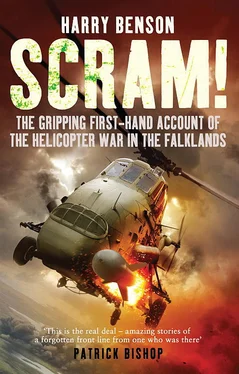Learning to fly helicopters is an expensive business. The Navy wants to make sure its pilots can learn as quickly and efficiently as possible. It’s far cheaper to get used to the unfamiliar environment of being airborne in a fixed-wing aircraft than a rotary one. So the first seventy-five hours of our flying training involved a few months based at RAF Topcliffe in Yorkshire learning to fly the Bulldog, a small single-engine propeller-driven aeroplane that was a vast improvement on the Chipmunk. After just eight hours flying, the instructor stepped out and left me to fly my first solo. Aerobatics, navigation training, night-flying and formation flying were all progressively introduced to us. The Bulldog was easy to fly and our time passed all too quickly.
We moved down to Cornwall and our first real taste of proper Navy life at RNAS Culdrose for Basic Flying Training on the Gazelle helicopter. All helicopters are inherently unstable. Left to their own devices, they would much prefer to roll over and crash than remain in stable controlled flight. Having arrived with a confident belief that our ability to fly Bulldogs made us masters of the universe, we were put firmly in our place by our feeble slapstick attempts to hover a helicopter.
In any helicopter there are three sets of controls. The collective lever sits in the left hand. Raising it up adjusts the pitch on all of the blades at the same time. Increasing the angle of attack to the wind through the blades causes the helicopter to rise up. The cyclic stick in the right hand alters the angle of attack of the blades at only one point in the rotor disc, causing the entire disc to tilt forwards, backwards, left or right. The pedals increase or reduce the angle of attack in the tail rotor, whose purpose is to counter the torque or twisting motion of the aircraft. Newton’s laws tell us that every action has an equal and opposite reaction. If the main rotor blades are spinning one way, the aircraft fuselage will try to spin the other. The tail rotor prevents this from happening.
Learning to use any one control at one time is easy enough. The problem is in learning to use all three at the same time. Pulling in power on the collective requires simultaneous use of the pedals to correct the tendency to yaw. But the additional downdraft on the aircraft fuselage means that an adjustment is also needed with the cyclic stick. For the Gazelle, a vertical take-off means lifting the collective, pushing smoothly on the right pedal, and easing the cyclic back and to the right. Now comes the hard part. A movement on the cyclic to tilt the disc also means that the thrust from the disc is no longer vertical. A compensating increase in power is required. Raise the collective lever and all the other controls need further adjustment. And so on. Hence the comedy value of trying and failing to maintain a hover for the first time within an area the size of a football field. Concentrating on adjusting our height above the ground, we would neglect to stop the helicopter from racing sideways across the ground. All of us very quickly became hopelessly out of control.
Fortunately our instructors were tolerant of our early incompetence, up to a point, and we either learnt fast as expected or faced being chopped. Six months and eighty hours flying time later and most of us were completing our captaincy checks before being awarded our wings. My own captaincy check was fantastic fun. I had to recce and land on top of Longships Lighthouse, just off the coast of Land’s End. Wings are the motif that Navy pilots wear on their left sleeve. Being awarded my wings was an extremely proud moment.

Little did I know that I would be on my way to war exactly a year after my first solo flight in a helicopter. Altogether I spent eighty hours learning to fly these sporty Gazelles, based at RNAS Culdrose in Cornwall, before progressing onto the bigger Wessex at RNAS Yeovilton in Somerset.
At this point, our training course of nineteen pilots went their separate ways. Twelve pilots were appointed to stay at Culdrose and do their Advanced and Operational Flying Training on anti-submarine Sea King Mark 2 helicopters. They would become pingers , named after the pinging sonar that Sea Kings dip into the sea in order to hunt submarines. I and six others were appointed to head up to Yeovilton to become junglies , the Navy’s commando squadron aircrew tasked to support the Royal Marines.
And so we learnt to fly the Wessex HU Mark 5. By the time I flew my first Wessex in 1981, the old bird had already been around for sixteen years. The Wessex was a whole different animal compared to the Gazelle. Whereas the Gazelle was light, fast, and handled like a sports car, the Wessex seemed heavy, slow, and handled more like a tractor. But once we got to know her, we quickly fell in love. The controls may have seemed sluggish at first. But we learnt to see them as forgiving. For a large helicopter of seven tons at maximum all-up weight, the Wessex was extraordinarily manoeuvrable. My personal record was of throwing a Wessex into a 110-degree wingover turn. That’s as near to upside down as I could get without the rotor blades flapping vertically upwards and applauding my impending crash. Having both frightened and impressed myself in equal measure, I resolved to be a little less ambitious in my aircraft handling. It never lasted. The Wessex was simply too much fun to fly.
Once started, the Wessex was incredibly reliable; the problem was getting it started. The electric cables didn’t seem to like damp weather. I only ever had three emergencies in 700 hours flying a Wessex before, during and after the Falklands War. And they all happened on consecutive days. An engine failure was the first. I lost the primary hydraulic system on the very next flight and the secondary system the day afterwards. Had these latter two happened at the same time, I would now be dead. Without hydraulics, seven tons of air through the rotors would have caused the cyclic stick in the cockpit to thrash around wildly out of control.
Our Advanced Flying Training on the Wessex was spent mainly at Merryfield, south-west of the busy main airfield at Yeovilton. Our Gazelle training mostly took place in the same way at Culdrose’s satellite airfield Predannack. The ten-minute transit to and from Merryfield became a familiar routine that was usually an enjoyable journey free from practice emergencies thrown at us by our instructors. After just seven hours flying time of circuits and basic emergency drills it was an exhilarating feeling when my instructor Lieutenant Mike Crabtree jumped out and let me loose on my own for the first time.
Over the next few months, we practised basic circuits, instrument flying in cloud, navigation, night-flying and formation flying. On almost every sortie, we would practise autorotation, the emergency procedure needed when everything turns to a can of worms. If either the engines or transmission or tail rotor fail on a helicopter, the pilot’s only weapon to avoid making a big hole in the ground is the momentum in the rotor blades. In the same way that winged sycamore seeds spin around of their own accord as they descend from a tree, helicopters can descend without power under some semblance of control. Of course for a seven-ton helicopter (about the same weight as an old red London double-decker bus) the rate of descent is more akin to a flying brick than a graceful sycamore seed. But the principle holds. By dumping all power immediately you sense a problem; the blades continue to rotate on their own – hence ‘auto-rotation’ – driven by the wind now passing up through them as you descend.
So when disaster strikes, the pilot’s first job is to dump the collective lever immediately. You have about one second to do this before the rotor blades slow down irreversibly. Dumping power reduces the drag on the blades. But it also reduces the lift that keeps you in the sky. As you descend rapidly, you are looking out for some suitable field or other landing point just in front of the helicopter’s nose. The choices are fairly limited once your helicopter has become little more than a rotary glider. At a critical moment, some 100 to 150 feet above the ground, you ease back on the cyclic to raise the nose, reduce forward speed, slow your rate of descent, and give the blades a bit of extra momentum as the wind through them increases. At about ten to twenty feet above the ground, you are aiming to wind up the flare so that the helicopter almost reaches a stationary hover. But with no power to keep the blades rotating, you are only going one way. Down. The final task is to haul on the collective lever and use all the remaining momentum in the blades to cushion the landing. We practised endless ‘autos’ from a variety of positions in the sky: from 1,000 feet, 200 feet, upwind, downwind, from high and low hovers. To our instructors’ considerable credit, and despite the huge size of the Wessex, none of us ever pranged.
Читать дальше













